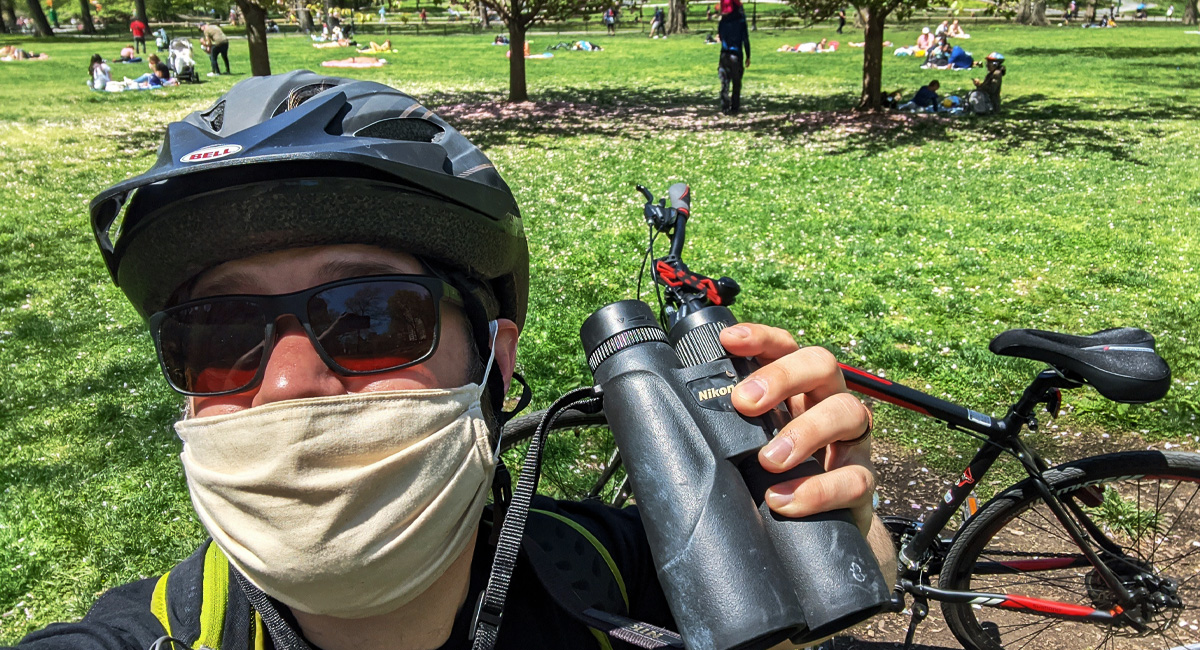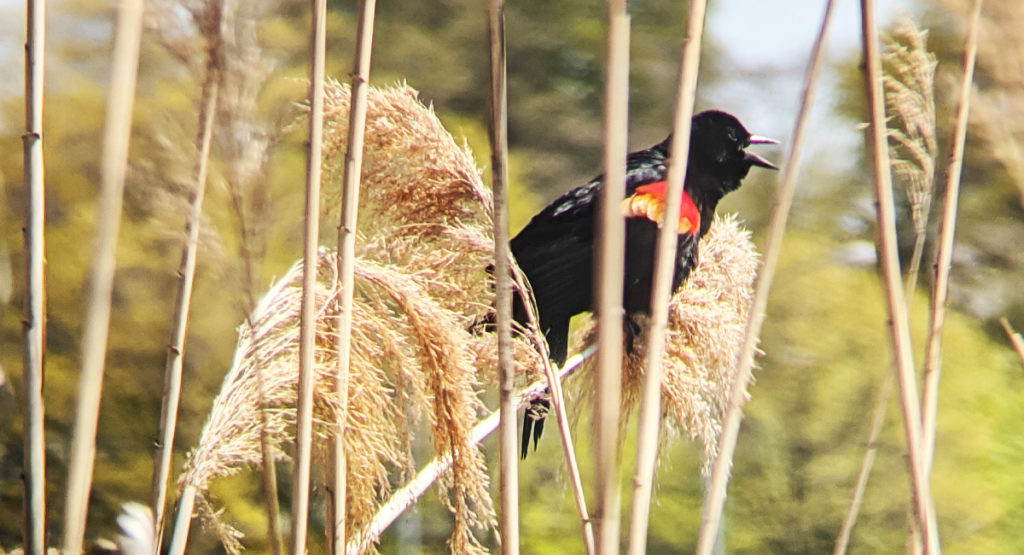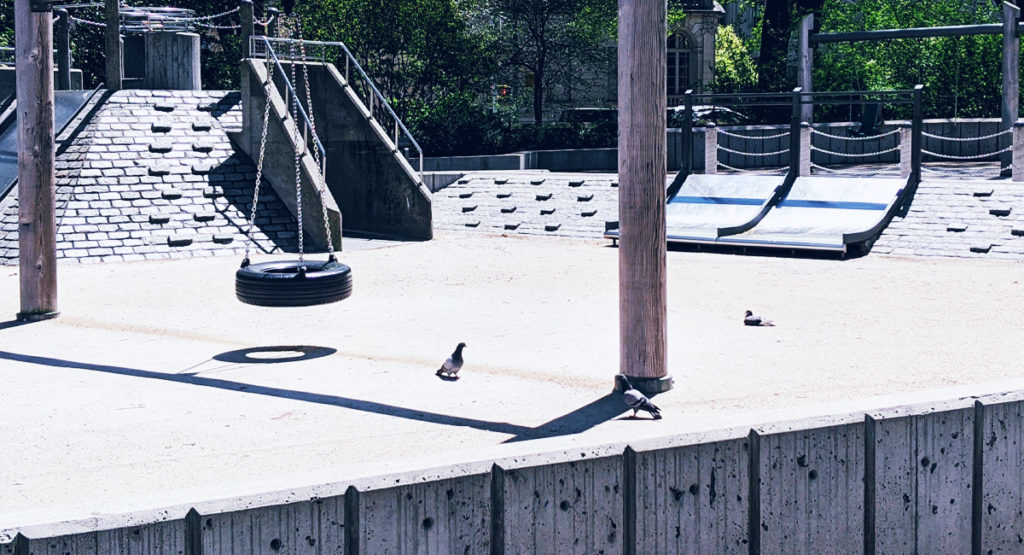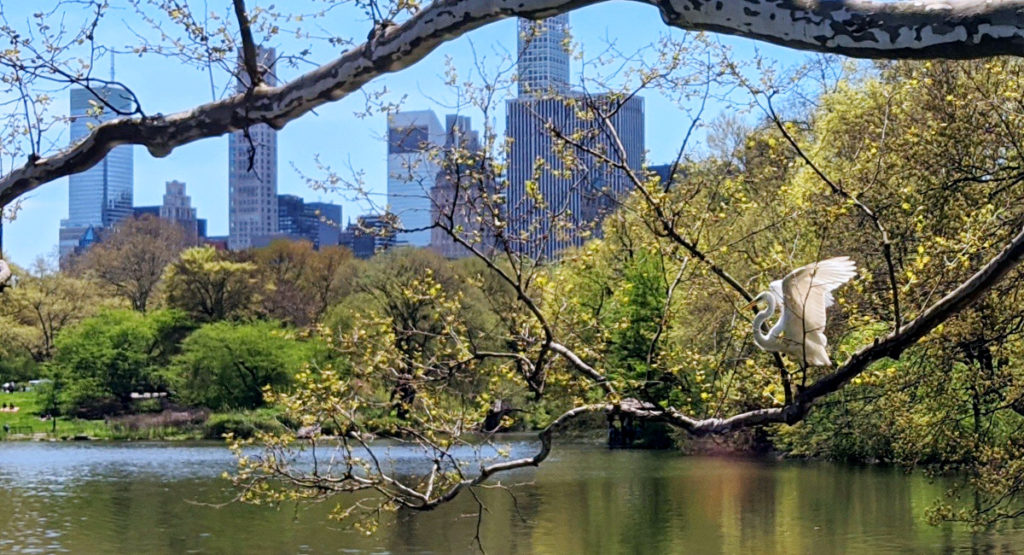
I’m not a great birder. Not even a good one. I’m basically only a birder in contrast to people who’ve never even heard about birding.
Ten years ago, as a naive Penn State student who had just switched from Film & Video to Parks & Rec, I was just having my first taste of birdwatching. I mean, I’d seen birds before. Sure. Never really paid much attention to them. On a mid-January day, enjoying a lunch break from classes at Shaver’s Creek, I peered out of the large window of the Lower Classroom, a front-row seat to busy bird feeders. As I crunched carrot sticks and got to know my peers, I was impressed at how confidently they called out words that were foreign to me: juncos, titmice, chickadees. Oh, birds! I didn’t know any of them, but they sure were cute. I was pretty sure I could identify a robin. Like… ninety-percent sure.
Nowhere to go but up, really.
As spring bloomed and we learned tons about plants and mammals and team-building and exhibit design, the kind of stuff I expected to enjoy, I had also come to appreciate getting up close and personal with a diverse array of birds. For some reason this surprised me. And while some of my fellow students already knew a lot, the Shaver’s Creek instructors were savants. I slowly came to understand how specific field marks can lead to quick IDs, which birds were migrating through and which ones overwintered here, and how important being in the right habitat for the right bird is. And then there’s birdsong. The depth of these experts’ intuition when it came to auditory recognition stunned me. Birding by ear? With such certainty? It would take me many, many more years to develop some semblance of this skill. To this day, I’m still in awe of what they hear when they step outside.
In May of that year, I participated in my first Birding Cup. If you’re reading this, you probably know what it is: a 24-hour, team-based competition to find the most bird species. (It’s also a fundraiser, a terrific citizen science initiative, and lots of other things.) I wouldn’t have done it alone, but Doug Wentzel encouraged us students to do it, so a few of us formed a small team. And it was an absolute blast. I’ve never had so much fun discovering the joy of whip-poor-wills on a dusty road, calling for owls and hearing a response (hopefully it wasn’t another human), waking up before dawn to a Chipping Sparrow outside our cabin. An unforgettable evening, night, morning, and afternoon. A day where everything else melted away except for us and the birds. It was eye (and ear) opening.

I repeat: I’m not a great birder. Still not. I don’t often go out on my own to intentionally look for birds. I don’t think to bring binoculars with me when I go for walks or bike rides. I’m not an early riser. But through sheer proximity of working closely with Shaver’s Creek staff over the many years that followed, I was privileged to tag along with brilliant birders over the years, both in the great backyard of central PA and occasionally farther-flung places. (And it’s not just Shaver’s Creek staff — I was exposed to dozens and dozens of brilliant birders; it’s a vibrant community out there.) With folks like this leading me around, I’ve seen hundreds of birds I never would have seen otherwise.
The thing about tagging along with amazing birders — and I love them! — is you are kind of at their mercy. You gotta keep up with their pace, especially when they’re in a new place, on a roll, trying to check as many species as possible off the list. You mutter “mm-hmm” as if you also recognize the difference between hairy and downy woodpecker drumming. Don’t get me wrong, they’re not usually blurting out every single species faster than I can even pinpoint them; the best birding mentors give amateurs like me time to figure it out or at least build up a profile of it to analyze and figure out while flipping thru a Sibley’s back in the car. They are patient and gracious and you can tell they genuinely enjoy teaching. This has happened to me loads, and I am incredibly appreciative. But if there are no rare birds in a spot and we’re chasing morning light and there might be something more interesting elsewhere, they’re also not sticking around to look at chickadees. (Unless they’re Mountain Chickadees and we’re in the Rocky Mountains of Colorado.)
While I cherish so many memories of birding with the big-leaguers, there is something much different about going out on my own and building up knowledge through straight-up experience. What can I find? What can I identify? It’s a challenge of the self; it’s a thrill to hear a very specific song that you know you’ve heard before but can’t place just yet — then just to your left, the sound of leaves being kicked around, and finally a visual: the yellow cheek of a White-throated Sparrow. Or, maybe, a life bird appears unexpectedly, like a Worm-Eating Warbler, in plain sight on the bank of the Lower Trail. (“Guys, that’s not a Chipping Sparrow.”) Moments like that reinforce the memory, recalibrate the birding sensors. They make you look around more curiously, more eagerly, with wonder.
I probably could have joined Birding Cup teams with experienced birders. Maybe even a winning team. But let’s face it, I’m not much of a Monopoly player; I’m much more of a MAD Magazine the Board Game kind of guy. (Obscure reference key — in MAD, the goal is to lose all your money through a series of ridiculous tasks like walking around the table backwards with your paper money balanced on your head. Less mortgage payments, more absurdity.)
No, for my next years doing Birding Cup, I dragged my closest friends along. With my student peers off to explore other parts of the world, I nagged/intrigued my housemates, who, like me, needed to learn the difference between a titmouse and a chickadee. To my surprise, they agreed. We trained in nearby parks. We listened to CDs. We went to Migration Morning bird walks to prepare. We planned routes. We planned snacks. We listened to the Goldeneye 007 soundtrack when scanning bodies of water for goldeneyes. We had intense discussions about comical team names (one year Game of Thrones themed; another Star Trek). I didn’t expect them to be into it. I didn’t expect them to improve their visual and auditory skills at such a rapid rate. I didn’t expect them to take up birding in their own spare time!
I didn’t expect that they’d be the ones asking me to continue joining up as a Birding Cup team for the next eight years.
Eventually, I moved. When I arrived in New York City last fall, I had about a decade of assorted birding experience under my belt, a decade of gradually absorbing bird knowledge from the pros and leeching bird enthusiasm into my circle of friends. But, frankly, I still didn’t bird much on my own. Yeah, I set up bird feeders, but they were just as much for me and the birds as for the cat to have entertainment in her windowsill. Besides, there was nothing much to see besides the usual suspects: House Sparrows, Rock Pigeons, and Mourning Doves. I had a pair of binoculars by the window with dust slowly building up on them.

Still, I was definitely lamenting the fact that my friends and I were living in such different locations, and there was no chance we were going to get the band back together this May for Birding Cup. Sorry, Purple R. R. Martin’s Larks of Winterfell. You’ll rise again another year…
Classic, in-person Birding Cup is like nothing else. You’ve got a ridiculous, compelling challenge in front of you. Drop what you’re doing for twenty-hour hours straight and look for birds. But decades of participation have honed a culture around it. The trophies smartly divided to reward different skillsets and ambitions. The team names are (obviously) a delight to brainstorm and joy to review. So many people are contributing to citizen science and fundraising for bird-related projects. The people are terrific. There’s nothing like running into random teams who happen to share an obtuse hint about something you heard in a different habitat an hour ago. Then meeting up with all the groups, exhausted, sharing stories of what you heard in the night and what you woke up to. And the birds, of course. Or the first time your plan to see the Black-crowned Night Heron — which was there yesterday, dangit — actually pans out. It’s much more than the sum of its parts. Some people call it their favorite day of the year, and I get it.
Birding Cup is sacred to many, and I wouldn’t have it any other way. It’s relegated to central Pennsylvania for a reason. All those reasons! All those wonderful, in-person reasons. Of course.
Then, COVID came.
I am committed to finding silver linings in the shadow of COVID.
It was an utter delight to see the Birding Cup mixed up, adapting to this year’s new need for physical distancing. It could have just been business-as-usual, central PA-only, socially distanced birding; could’ve been canceled altogether. Instead, Birding Cup blew wide open. Shaver’s Creek invited people from anywhere over the world to participate. Forget the trophies for now. The truly important things are the friendships, the camaraderie, the birds — all that can still shine through in chat rooms and stories on the phone and eBird checklists and Zoom calls.
I wasn’t sure if I was going to participate, but… I couldn’t help myself. I was inspired.
If I’m being honest, the first day of Birding Cup 2020 was the first day since I moved here that I saw something other than sparrows, doves, and pigeons (okay, maybe some gulls and starlings, too). I filled up my water bottle, stuffed my backpack with apple slices, and hopped on my bicycle, riding from my apartment in Queens to Central Park. I discovered so much, learned a lot about the landscape around me, and saw a lot of familiar feathered faces. (Look, once more: not a good birder; it wasn’t that many, but they were still all great to see, and one or two had me pull out the ol’ field guide.) And I got an amazing look at a Great Egret! Stunning. I stood there for ten minutes. I pointed it out to a lot of other people who were about to walk right past it, without bothering to ever look up. They were in awe, too. It was magnificent.

And I had a blast sharing my observations with people on the Birding Cup Discord (chat room), sharing photos, asking ID questions. It felt like Birding Cup, in essence — I was still on a mission to find as many birds as I could. I was still out there figuring it out on my own, texting my friends photos of my sightings and recordings. Mulling over field guides. Appreciating newfound natural spots. And to think, there were people all over the country — actually, the world — having awesome birding experiences wherever they are. Maybe birding with their families for the first time. Maybe getting some fantastic solo time, flexing their own birding brains in new ways.
And over 40,000 individual birds catalogued on eBird? That’s insane. Incredible.
Something about looking for birds for 24 hours straight rewires your brain. There’s a residual effect. You can’t help but stop in the middle of the sidewalk when you really should be going somewhere because “was that a mockingbird singing just now?” You start carrying your binoculars with you on walks — not just the walks where you were hoping to find birds, but maybe on your way up to the post office. You keep tallies. You use eBird.
A few days after Birding Cup ended, I strapped on the ol’ binocs again and biked to a different location. I think I had just as much fun. I found another Great Egret. I had a terrific look at a pair of flickers neighboring a wildly empty Citifield parking lot. I might have even put on a very particular James Bond soundtrack while scanning the Flushing Meadows lake for waterfowl…
Now I’m planning another biking birding trip. It’s the best. What better way to get out of the house right now and learn so much about the world around me? Thanks, Shaver’s Creek, for opening up the Birding Cup at the time we needed it the most.

Love the pictures and the article!
What a great piece, Justin! And so glad that you have found a ‘silver lining’ (and some Great Egrets) there in NYC. Thank you for sharing your most amusing birding journey.
Justin, that was a great article!
I loved reading it, loved the photos, and loved your thoughts!
This is great, Justin! Thank you so much for your story and style. You are missed. Have a blast expanding your birding brain.
Awesome!